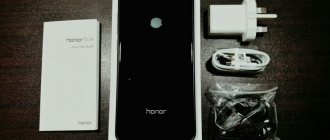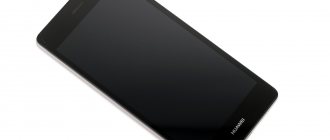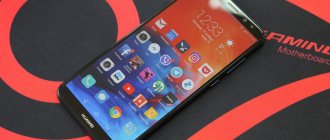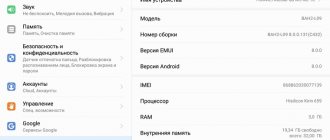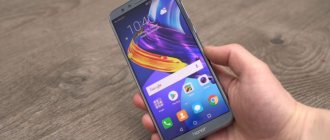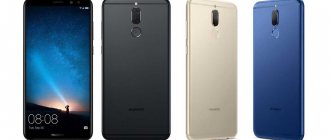Parameter table
In the table below we indicate the main characteristics of both smartphones. Changes in parameters will be highlighted in red/green. Green is good, red is bad.
| Lite | P8 | |
| Price | 10-13 thousand rubles | 15-16 thousand rubles |
| Display | 5 inches, 1280×720 | 5.2 inches, 1920×1080 |
| CPU | Kirin 620 | Kirin 930 |
| Graphic arts | Mali-450 | Mali-T628 MP4 |
| RAM | 2 GB | 3 GB |
| Disk memory | 16 GB | 16 GB (different versions available) |
| Rear camera | 13 MP, F/2 | 13 MP, F/2, optical stabilization, ISP processor |
| Battery | 2200 mAh | 2680 mAh |
Rear camera, price, display, hardware, battery, amount of RAM - all these parameters are different in these smartphones. But the cost is logically different. And now more details.
I can’t enter the Android engineering menu: reasons
- Firstly, many smartphones or tablets with Qualcomm Snapdragon, Intel or Tegra processors either do not have a menu or are very difficult to access. In some cases, you don't even have to try.
- secondly, custom firmware may be the cause of the problems. In a number of them, access to configuration tools is simply absent or blocked. For example, you will not find an engineering menu in the CyanogenMod firmware, which is very popular among users. The reason is simple - the firmware was originally developed for Snapdragon-based devices.
- thirdly, the source of the problems may be the manufacturer himself, who hid the engineering menu more reliably or decided to remove it altogether. This also includes various types of errors from which none of the devices are insured.
More about Huawei: HUAWEI Honor 8 Lite codes, Show more - HardReset.info
Actually, solutions to problems lie on the surface. If the smartphone is powered by Snapdragon, Intel or Tegra, then in most cases nothing can be done. However, even on these devices you can access a number of hidden settings, which we will discuss below.
By the way, on Xiaomi smartphones, which are mostly based on chips from Qualcomm, you can access the engineering data by clicking several times on “Kernel version” in the smartphone settings (section “About phone”). Finally, in some cases, flashing your Android device to stock (official) firmware will help.
The second way to open access to the engineering menu is through applications. There are quite a few of them, you can download them for free from, but almost all of them are designed for smartphones based on the MediaTek processor. The MTK Engineering Mode application has proven itself quite well.
Again, it is not a fact that each of the programs will work smoothly on your device - there are a hundred reasons why they will refuse to function. These tools are developed by small companies, so you'll probably have to try a few.
Displays
The obvious difference is the diagonal and resolution of the display. The Lite version uses a 5-inch diagonal HD screen with an IPS matrix. Characteristics: white brightness is 190 cd/m2, black brightness is 0.4 cd/m2.
A possible drawback of the Huawei P8 Lite screen is the viewing angles - they are average. When viewed at an angle to the left or right, colors may distort into purple or yellow tones.
Conclusion: the matrix in the P8 Lite is budget-friendly, with low contrast, brightness and poor color rendition when viewed at an angle.
Huawei P8 lite screen in the sun
The screen in Huawei P8 is good and has maximum viewing angles. Look at the display from any angle – the picture on it is not distorted. It uses a cool IPS LCD matrix with a 5.2 diagonal and FullHD resolution, which will provide detail and the absence of pixelation (this is when individual pixels are visible on the screen).
There is a large reserve of brightness, the ability to adjust color temperature, and natural color rendition.
Viewing angles Huawei P8
The conclusion is obvious: the P8 has a much better display, not only because of the diagonal and resolution. Here are the best indicators overall.
Another alternative is engineering codes
Such codes were already implemented in old phones that did not have the ability to display detailed graphic information on the screen. A visual interface is absolutely not needed to use them.
There are a lot of engineering codes. We decided to provide information about those that are used most often (you can search for others on specialized Internet portals):
- *#06#. Used in a situation where you want to find out a reliable IMEI address;
- *#*#4636#*#*. Makes it possible to obtain some statistical data. About the device itself or its battery;
- *#*#7780#*#*. Rolls back OS settings to their original settings. Similarly, it returns factory settings for applications and Google Play services installed on the phone;
- *2767*3855#. After entering this command, the mobile phone will be completely formatted. You need to use it only after thinking it through and clearly understanding the consequences of such an action;
- *#*#34971539#*#*. The owner of the phone receives important information related to the functionality of the built-in camera;
- *#*#7594#*#*. Allows you to make adjustments to the mode settings of the button responsible for turning the mobile phone off and on;
- *#*#273283*255*663282*#*#. Allows you to navigate to the backup tool
More about Huawei: HUAWEI Honor 10 codes, Show more - HardReset.info
Processor comparison
The phones use proprietary Huawei chipsets: Kirin 620 in P8 Lite and Kirin 930/935 in P8. Different processors can be installed here - Kirin 930 or 935 (depending on the version of the smartphone and the amount of memory).
Let's start with the Kirin 620 in the Lite smartphone. This is a 64-bit 8-core processor with low-performance Cortex-A53 cores (28 nm process technology) and a Mali-450 video accelerator. The processor cannot be called high-performance, but it copes well with the user interface. The menu scrolls smoothly, there are no friezes or brakes in the menu, there are no microlags.
The Kirin 620 runs many games normally, but there are many applications where FPS noticeably sags and effects disappear. The test results speak for themselves - in the Antutu benchmark, the Kirin 620 in the Huawei P8 Lite scored 34930 points.
This result is slightly below the average for smartphones in this price category, but it cannot be called bad.
The HiSilicon Kirin 930/935 processors used in the P8 are slightly different from each other. The 935 model is an “overclocked version” of the 930, so to speak, and it operates at higher frequencies – 2 GHz. Both processors have 8 Cortex-A53 cores and Mali-T628 MP4 graphics.
The result of the synthetic test is better - 50556 points in the Antutu benchmark.
The P8 smartphone is better in terms of performance than its “younger brother” Lite.
Realme 8 vs Huawei P40 Lite: Antutu benchmark
In the AnTuTu benchmark test, Realme 8 scored 301228 (score / points), which is 4.75% faster than the result of Huawei P40 Lite (287558 points). Below you can compare its performance with other models based on the Antutu benchmark rating. This will really help you make a better choice than subjective tops, reviews and testimonials.
Realme 8 6.4″ (2400×1080) Gorilla glass / Helio G95 / 6GB / 128GB / 64MP / 5000mAh
14789.38rub
$202.70
301228
Huawei P40 Lite 6.4″ (2310×1080) Curved Glass / Kirin 810 / 6GB / 128GB / 48MP / 4200mAh
0.00rub
$0.00
287558
View full table
Cameras
Let's start with the P8 Lite. This phone uses a 13 megapixel module with f/2.0 aperture. Focus is fast and accurate, white balance rarely misses. The user can select shooting modes. There is a function for selecting the focus point immediately after shooting, “successful photo” - the ability to select the best frame from the series. HDR included. The front camera is standard and takes good pictures too, but we won’t focus on it.
Examples of photos on Huawei P8 Lite
The P8 has a 4-color RGBW sensor made by Sony and has optical stabilization. If you compare photos from the P8 with frames from the Lite model, you can’t say that there is any fundamental difference: the older model shoots a little better, but the difference in quality is noticeable only when studying the image very closely. It is impossible to tell by eye the difference in photo quality on the cameras of both phones. And that's great for the Lite model.
The advantage of the Huawei P8 camera is its cool macro . A distance to the object of 3-4 cm is a good indicator. In the cool cameras of the Meizu MX4 Pro or HTC One M8 smartphones, this distance is 6-8 cm. But in general, when shooting during the day, the photos turn out good. The stabilization of the optics deserves special attention - the work of this module is visible here like nowhere else. When the camera moves, the picture on the screen also moves smoothly, making it a pleasure to take pictures and shoot.
Shooting at night also makes a good impression. Yes, there is sometimes blurring and blurring in poor light, but the difference between competitive sensors and the P8 camera is immediately noticeable - the quality is better in favor of the latter.
Examples of photos on the Huawei P8 smartphone
What is an engineering menu and what is it for?
The engineering menu for Huawei and Honor is a program built into Android.
But keep in mind that some developers deliberately delete the program after all checks. After this action, it will be difficult for the user to customize the application for themselves. Therefore, some people download a separate program with similar actions or use firmware developed by developers of other equipment manufacturing companies. It is noteworthy that the option on Huawei phones and tablets is always located in a specific place and is not removed by the manufacturer. Therefore, if you didn’t open it right away, you just need to perform the steps again. Keep in mind that incorrect installation will not improve the performance of your Android-based gadget (smartphone or Mediapad tablet), but rather will aggravate the problems. If such breakdowns occur, the client is solely responsible. It will not be possible to make a warranty claim.
It is noteworthy that the function is not in a prominent place. You need to know exactly how to connect it. This is done to prevent an inexperienced user from messing up the settings. Also, this option is not needed for permanent use. It is enough to set the parameters once and use their results.
Autonomy
Considering the fact that the manufacturer does not officially provide data on the autonomy of the P8 Lite, we can conclude that things are bad with this. In practice, you can use it 8 hours a day with LTE turned on, infrequent calls and background processes such as Twitter, WhatsApp. In this mode, it will live from 12 noon until 8 pm, and then discharge. That is, autonomy leaves much to be desired. The manufacturer even reduced the maximum brightness of the backlight in order to achieve at least a little more autonomy, but this helped little.
In theory, the P8 Lite's battery will last until late in the evening if you turn off LTE, 3G Internet and Wi-Fi when they are not needed.
As for the model without the Lite prefix, things are better here: the phone will live from morning to evening in standard operating mode:
- 60 minutes of calls;
- A dozen SMS;
- 4 hours of music playback;
- 2 hours of Internet 3G or LTE;
- About 50 photos.
In this mode, the phone will have to be charged in the evening, but this is not bad.
Information alternative – project menu
In some phones, the manufacturer decides to abandon a full-fledged engineering mode, believing that it has no use for the average person. Sometimes, instead of it, after entering the appropriate password, an alternative appears - Project Menu.
What is the difference? It lies in the fact that Project Menu is purely informational in nature:
- Battery Charge. A section that allows you to obtain information about the charge level of the battery used, the degree of its heating;
- Network Information Query. Provides information on the SIM card, the country where the smartphone was produced;
- Veneer Information. Various information about the OS version, other built-in programs, manufacturers.
However, there are a couple of sections that allow you to perform certain actions:
- Restore Factory. Used to roll back the phone settings to the original factory settings;
- Software Upgrade. Provides the ability to upgrade the software used;
- Background Settings. You can change the color of the theme used, debug the operation of the USB port, if there is one, and change some other characteristics.
In general, if there is no full-fledged engineering mode, then some tools can be obtained using this somewhat truncated version.

